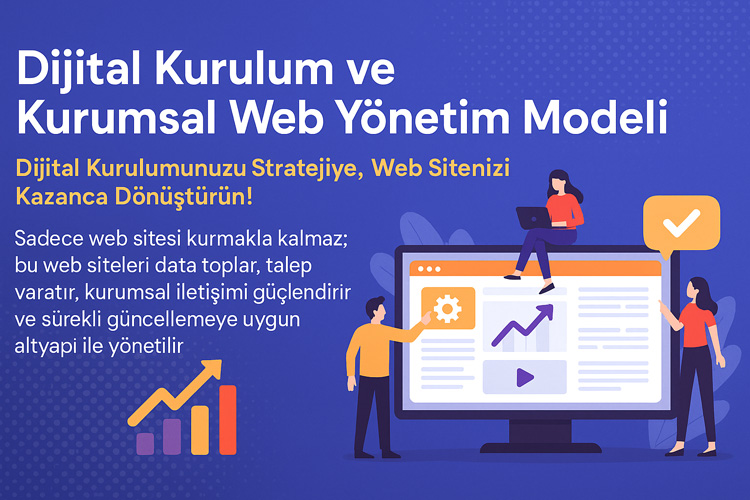The process of opening a website, in other words setting it up, may sound complicated at first, but with our step-by-step approach, this process is both fun and educational for you. /strong> will turn into an experience. The most important step for those who say “I want to open a website” is to determine a clear goal and strategy. First, clarify the purpose and target audience of your site. This will be the cornerstone of your further steps.
Cost is usually among the most curious ones. “How much does it cost to open a website?” The answer to the question varies depending on the size and needs of your project. The cost required for a simple blog will be lower than for an e-commerce site. Determine your budget and search for the most suitable hosting and domain options accordingly. Remember, you don’t need to allocate huge budgets to get started; You can also establish a successful site with cost-effective and quality services.
Technical requirements and design elements have an important place when opening a website. When we say “what you need to open a website”, the first thing that comes to mind should be a user-friendly interface and an effective user experience. A good website offers your visitors a fast and smooth navigation experience. So, try to keep your designsimple yet impressive

The last step is to publish your website and keep it updated. This is where SEO (Search Engine Optimization) comes into play. A good SEO strategy makes your site more visible in search engines. Remember, even after your website is live, it is important to keep it lively and up-to-date with regular content updates and technical maintenance.
By following these steps when opening or setting up your website, you will save your budget and have an effective and successful website. The road to success is possible with correct planning and step by step progress! 🚀
For those who say
I want to open a website, we offer a step-by-step road map under the title “From Start to Finish: Guide to Opening a Website”. Your first step should be to set a clear goal and strategy. This is a critical starting point for those who want tobuild a website and will form the basis of your website.
Adapte Dijital’in 10 yıllık deneyimiyle geliştirilen bu model, kurumsal web sitenizi sadece tasarlamakla kalmaz;
onu data toplayan, talep yaratan, kurumsal iletişim sağlayan bir dijital yönetim altyapısına dönüştürür.
Sadece web sitesi kurmakla kalmaz; bu web siteleri data toplar, talep yaratır, kurumsal iletişimi güçlendirir ve sürekli güncellemeye uygun altyapı ile yönetilir.
If you are wondering how much it costs to open a site, these costs vary depending on the size and needs of your project. The cost of a simple blog is lower than an e-commerce site. it could be. Therefore, it is important that you research cost-effective hosting and domain options. You do not need to allocate high budgets to set up a new site; You can also achieve successful results with cost-effective solutions.
Among the requirements for opening a website, it is important to create a user-friendly interface and an effective user experience. Those who say “I want to set up a website” should take care that their sites offer visitors a fast and fluid navigation experience. A simple but striking design can leave a permanent mark on your visitors’ memories.
Finally, once the website creation process is complete, it is critical to regularly update your site and implement SEO (Search Engine Optimization) strategies. Good SEO work ensures that your site ranks higher in search engines. Remember, regular content updates and technical maintenance keep your website lively and up-to-date.
İçindekiler
TogglePlanning Your Website Project: Goals and Strategies
Establishing a website Your first step in the process of opening a website should be to determine your goals and strategies. This will serve as the cornerstone of your project and shape your entire process. Clarify your goals and plan which paths you will follow to achieve them. Whether it’s a personal blog or a business website, starting with a clear vision will ensure your success. n is the key. 🌟
Define Your Target Audience
Defining your target audience is critical for anyone who says I want to open a website. Understanding who you are trying to reach and their needs will shape your content and design. Demographics, interests, and behaviors play a key role in this process.
Create a Content Strategy
Quality content is the lifeblood of the process of establishing a website and opening a website. Your content strategy should include information that will interest your target audience and attract them to your site. Blog posts, videos, infographics… Decide which formats you will use and share these content regularly.
Focus on Design and User Experience
User experience plays a big role in the success of your site. Requirements for opening a website include ensuring that users can easily navigate your site and easily find what they are looking for. Elements such as navigation, color scheme, and font selection greatly affect users’ interaction with the site.
Adapte Dijital’in 10 yıllık deneyimiyle geliştirilen bu model, kurumsal web sitenizi kurumunuzu/markanızı anlatan, tanıtan, güven yaratan, talep oluşturan bir dijital yönetim platformuna dönüştürür.
Adapte Dijital, bu modelde bir konumlandırma ajansı olarak çalışır. Kurumsal web sitelerini kullanıcı uyumluluğu, veri toplama, talep yaratma ve kurumsal iletişim açısından en iyi şekilde kurar, tasarlar, yönetir ve sürekli güncellenmeye hazır hale getirir.
Improve Your SEO and Marketing Strategies
Take your site beyond the process of setting up a new site and opening a website. SEO (Search Engine Optimization) and marketing strategies will increase your website’s visibility and attract more traffic. Keywords, backlinks and social media usage are indispensable parts of this process.

Basic Requirements and Tool Selection for Opening a Website: Hosting, Domain and Platforms
The most basic requirements in the process of opening a website are hosting, domain (domain name) and platform selection. These three elements form the foundation of your website and directly affect the quality of your online presence. Making the right choices is vital to the performance, security and accessibility of your site. These decisions are critical to yourlong-term success. 🚀
Some basic requirements and choosing the right tools are vital to successfully create, open and publish your website. Hosting is where your website will be hosted on the internet and directly affects the speed, security and accessibility of your site. Choosing a reliable and performance-oriented hosting service ensures that your site runs uninterruptedly and quickly.
Domain selection creates the online identity of your website. Choosing a domain name that is catchy, reflects your brand, and is easy to spell will make it easier for visitors to remember your site and revisit it.
Finally,the choice of web platform determines the functionality and manageability of your site. Choosing a platform that suits your needs and technical skills will have a big impact on your website design and content management. Popular platforms like WordPress, Wix, Shopify cater to different needs and skill levels. The correct selection of these key elements forms the basis for the successful operation of your website.
Evaluate Hosting Options
Hosting is where your website will be hosted on the internet. Choosing a reliable and fast hosting service directly affects the loading speed and accessibility of your site. Make your choice by considering factors such as server type, storage capacity and bandwidth.
How to Choose the Right Domain?
Domain is your brand’s online identity. Choosing a domain name that is catchy and reflects your brand makes it easier for your visitors to remember you. Make sure your domain name is short, meaningful and compatible with your brand.
Find the Most Suitable Web Platform
The platform you will use to create a website will have a great impact on the functionality and manageability of your site. Choose from a variety of platforms such as WordPress, Shopify, Wix, etc., which best suits your needs and technical skills. Each platform has differentfeatures and limitations
Additional Tools and Plugins
You can use additional tools and plugins to increase the functionality of your website. There are many options available such as SEO tools, security plugins, social media integrations. Choosing the plugins that best suit your needs will improve your site’s user experience and search engine performance.
Elements of Website Design: User Experience and Aesthetics
Web site design not only creates a visual impact, but also deeply affects user experience. Creating a design that suits your users’ needs and expectations increases their interaction with your site and their loyalty to the site. A good design should strike a perfect balance between aesthetics and functionality. In this section, we will cover the basics of how to optimize your website for user experience and aesthetics. 🎨
Your website design shapes users’ initial and ongoing interaction with your site. User Experience (UX) enables your visitors to navigate your site comfortably and effectively. This is closely related to the ease of navigation, content accessibility and overall understandability of your site. A good UX encourages visitors to revisit your site and increases brand loyalty.
On the other hand, visual aesthetics determine the overall look and feel of your site. The color scheme, typography, and visual arrangement should reflect your brand’s personality and capture the attention of your target audience. A consistent and attractive visual design strengthens users’ interactions with your site.
Finally, mobile compatibility of your site is a mandatory requirement today. Considering the increasing mobile usage of users, your site needs to be effective and functional on different devices and screen sizes. This increases your site’s accessibility and user satisfaction. Professional web design
Prioritize User Experience
User Experience (UX) determines how user-friendly your website is. Factors such as ease of navigation, speed of access to information and clarity of content affect how comfortable users will feel on your site. Understanding users‘s needs and designing according to these needs is critical to a successful UX.
Prioritizing user experience (UX) in website design is a key element that determines your visitors’ interaction with your site. A successful UX design ensures that users have a comfortable, effective and seamless navigation experience on your site. This starts with elements like ease of navigation, fast-loading pages, and clear information presentation.
Understanding users’ needs and behaviors is vital to effective UX design. To achieve this, collecting user feedback, It is necessary to conduct behavioral analyzes and continuous testing. Ensuring that users can easily find what they are looking for on your site increases their satisfaction and loyalty to your site.
Ultimately, improving user experience allows visitors to spend more time on your site, engage more, and ultimately convert into loyal customers. User experience strengthens not only your site’s usability, but also your overall brand perception and online success.
Visual Aesthetics and Design Elements
Visual aesthetics shape users’ initial reactions to your site. The color scheme, font choices, images and layout create the overall appearance of your site. Ensuring that visual elements reflect the tone and personality of your brand creates a memorable and impressive experience.
Consistency and Brand Identity
Opening a website is so important that maintaining a consistent design and brand identity on every page strengthens the perception of professionalism and reliability. Consistent use of elements such as logo, colors and fonts throughout your site increases your brand awareness and gives users confidence.
Mobile Compatibility and Responsive Design
Today, mobile compatibility is a must for every website. Since the majority of users access the internet via mobile devices, your site must also provide a user-friendly and effective experience on mobile devices. Responsive design allows your site to adapt to different screen sizes and devices.
Professional web design agency is.
Publishing and Managing Your Website: SEO and Updates
Publishing and establishing your website is just the beginning of your project. The real challenge is managing and optimizing it effectively SEO (Search Engine Optimization) and regular updates are critical to your website’s success. . In this section, we’ll cover the strategies you need to keep your site ranked top and stay current with rich content. 🔍
The success of your website lies in post-publishing management. SEO (Search Engine Optimization) helps you attract more visitors by ensuring your site ranks higher in search engines. Smart use of keywords, quality content and regular updates are essential components of SEO. Additionally, it is critical to keep users coming back by keeping your site fresh and up-to-date with regular content updates. Taking user feedback into account and performing technical maintenance ensures that your site remains secure and fast. Remember, constantly improving and updating your website not only maintains existing traffic but also attracts new visitors. In this process, paying special attention to SEO and updates determines the long-term success of your website.
Optimize SEO
SEO is vital to increase the visibility of your site in search engines. Elements such as keyword optimization, meta descriptions, title tags and quality backlinks help your site rank higher in search engines like Google.
Make Content Updates Regularly
Regular content updates keep your site fresh and relevant. Blog posts, newsletters and videos keep users coming back to your site again and again. Quality and up-to-date content is important to attract users’ attention and improve the SEO performance of the site.
One of the keys to a successful website in the digital world is regular content updates This ensures that your site stays live, up-to-date and relevant and encourages users to constantly return. Content updates are also evaluated positively by search engines, which increases your site’s SEO (Search Engine Optimization) performance.
Regular updates can be in the form of blog posts, news, videos or new product information. This content should be designed to attract the attention of your target audience and provide valuable information to further attract them to your site. Additionally, constantly reviewing and updating your existing content ensures that you provide users with the most up-to-date and accurate information.
Making regular content updates positions your brand as an authority in your industry and increases your credibility in the eyes of users. This strategy is an effective way to increase your site’s traffic and user engagement in the long run.
Adapte Digital is both a professional web design agency and serves as a corporate web design agency, you can get detailed information from our article.
Consider User Feedback
User feedback is a valuable resource for continuous improvement of your site. Use this feedback to improve users’ experiences. You can improve your site with surveys, comments and user behavior analysis.
Technical Maintenance and Safety Precautions
Technical maintenance and security ensure that your website operates in a healthy and safe manner. Regular updates, security patches and performance improvements maintain the speed and security of your site. Additionally, regular backups protect your site’s data from loss and damage.
Conclusion and Suggestion from Adapt Digital
The step-by-step processes and suggestions we cover in this guide are the cornerstones that will make your website successful. However, the most important factor in this journey is finding the right support and expertise. At this point, Adapte Digital can be the ideal solution partner for you.
Adapte Digital, with its innovative and customized solutions It aims to take you one step forward in the digital world. Working with us ensures that your website becomes the online face of your brand, rather than just a technical project. From SEO to user experience, from content strategy to technical maintenance, we are with you at every step with our expert team.
With Adapte Digital’s professional approach, cutting-edge tools and creative strategies, your website, It guarantees success in reaching and interacting with your target audience. We help build your brand’s online identity, not just a website.
In conclusion, building and managing your website is possible with proper planning, tools, and expertise. As Adapte Digital, we are here to walk this journey together by offering you special solutions and focusing on your needs at every step of this process. Take a step with us on your path to success and show your difference in the digital world. 🚀



















































